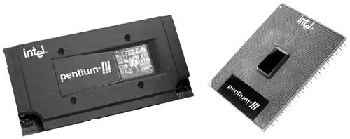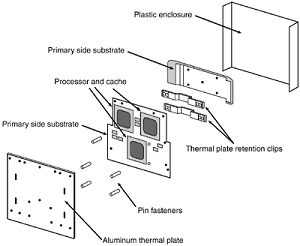Pentium III
The Pentium III processor, was first released in February 1999 and introduced several new features to the P6 family. It is essentially the same core as a Pentium II with the addition of SSE instructions and integrated on-die L2 cache in the later versions.

SSE consists of 70 new instructions that dramatically enhance the performance and possibilities of advanced imaging, 3D, streaming audio, video, and speech-recognition applications.
Originally based on Intel's advanced 0.25-micron CMOS process technology, the PIII core started out with more than 9.5 million transistors.
In late 1999, Intel shifted to a 0.18-micron process die (codenamed Coppermine) and added 256KB of on-die L2 cache, which brought the transistor count to 28.1 million. The latest version of the Pentium III (codenamed Tualatin) uses a 0.13-micron process and has 44 million transistors.
Motherboards made before the Tualatin-core versions of the Pentium III generally do not support this processor because of logical pinout changes. The Pentium III also became available in speeds from 450MHz through 1.4GHz, as well as server versions with larger or faster cache called Xeon.
The Pentium III also incorporates advanced features such as a 32KB L1 cache and either half-core speed 512KB L2 cache or full-core speed on-die 256KB or 512KB L2 with cacheability for up to 4GB of addressable memory space. The PIII also can be used in dual-processing systems with up to 64GB of physical memory.
A self-reportable processor serial number gives security, authentication, and system management applications a powerful new tool for identifying individual systems. Because of privacy concerns when the processor was released, you can disable this feature in the system BIOS on most systems that use the Pentium III or Celeron III processors.
Pentium III processors were first made available in Intel's SECC2 form factor, which replaced the more expensive older SEC packaging. The SECC2 package covers only one side of the chip and allows for better heatsink attachment and less overall weight. Architectural features of the Pentium III processor include:
-
Streaming SIMD Extensions. Seventy new instructions for dramatically faster processing and improved imaging, 3D streaming audio and video, Web access, speech recognition, new user interfaces, and other graphics and sound-rich applications.
- Intel processor serial number. The processor serial number serves as an electronic serial number for the processor and, by extension, its system or user. This feature can be enabled or disabled as desired in the BIOS Setup. The serial number enables the system/user to be identified by company internal networks and applications.
The processor serial number can be used in applications that benefit from stronger forms of system and user identification, such as the following:
Applications using security capabilities. Managed access to new Internet content and services; electronic document exchange.
Manageability applications. Asset management; remote system load and configuration.
Although the initial release of Pentium III processors was made in the improved SECC2 packaging, Intel later switched to the FC-PGA package, which is even less expensive to produce and enables a more direct attachment of the heatsink to the processor core for better cooling.
The FC-PGA version plugs into Socket 370 but can be used in Slot 1 with a slot-ket adapter. All Pentium III processors have either 512KB or 256KB of L2 cache, which runs at either half-core or full-core speed. Pentium III Xeon versions have 512KB, 1MB, or 2MB of L2 cache that runs at full-core speed.
The Pentium III Xeon is a more expensive version of the Pentium III designed for servers and workstations. All PIII processor L2 caches can cache up to 4GB of addressable memory space and include ECC capability. Pentium III processors can be identified by their markings, which are found on the top edge of the processor cartridge.
Pentium III processors are all clock multiplier locked. This is a means to prevent processor fraud and overclocking by making the processor work only at a given clock multiplier.
Unfortunately, this feature can be bypassed by making modifications to the processor under the cartridge cover, and unscrupulous individuals have been selling lower-speed processors re-marked as higher speeds. It pays to purchase your systems or processors from direct Intel distributors or high-end dealers who do not engage in these practices.
Pentium II/III Xeon
The Pentium II and III processors are available in special high-end versions called Pentium II Xeon and Pentium III Xeon processors (Intel now uses the term Xeon by itself to refer to Xeon processors based on the Pentium 4). Originally introduced in June 1998 in Pentium II versions, later Pentium III versions were introduced in March 1999.
These differ from the standard Pentium II and III in three ways: packaging, cache size, and cache speed. Pentium II/III Xeon processors use a larger SEC cartridge than the standard PII/III processors, mainly to house a larger internal board with more cache memory. The Pentium III Xeon processor is shown in Figure 2; the Xeon's SEC is shown in Figure 3.


Besides the larger package, the Xeon processors also include more L2 cache. They were produced in three variations, with 512KB, 1MB, or 2MB of L2 cache. Even more significant than the size of the cache is its speed. All the cache in the Xeon processors run at the full-core speed.
This is difficult to do considering that the cache chips are separate chips on the board; up until recently they were not integrated into the processor die. The original Pentium II Xeon processors had 7.5 million transistors in the main processor die, whereas the later Pentium III Xeon came with 9.5 million.
When the Pentium III versions with on-die cache were released, the transistor count went up to 28.1 million transistors in the 256KB cache version, 84 million transistors in the 1MB cache version, and a whopping 140 million transistors in the latest 2MB cache version, setting an industry record at the time.
The high transistor counts are due to the on-die L2 cache, which is very transistor intensive. The L2 cache in all Pentium II and III Xeon processors has a full 64GB RAM address range and supports ECC. Later versions of the Xeon processor were designed for Socket 370, and an even newer version based on the Pentium 4 is designed for Socket 603.